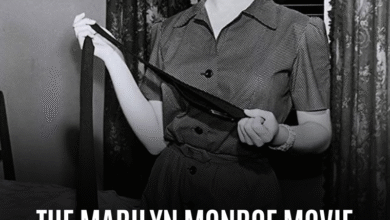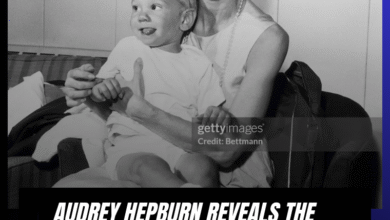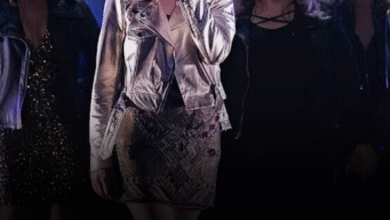The Film Audrey Hepburn Never Expected to Change Her Life Forever
OPINION: This article may contain commentary which reflects the author's opinion.
Audrey Hepburn, one of the most iconic actresses in film history, is often remembered for her elegant presence and timeless roles in classics like Breakfast at Tiffany’s and Roman Holiday. However, her path to stardom was not a simple one. Hepburn’s early years were marked by personal hardships, and her dream of becoming a ballet dancer was ultimately cut short. But through a series of pivotal roles, Hepburn found a way to not only realize her dreams but also redefine them, particularly with the help of a film that captured her heart and her true passion.
Early Life and the Dream of Dance
Audrey Hepburn was born on May 4, 1929, in Brussels, Belgium, into a tumultuous family life. Her parents divorced when she was young, and she spent much of her childhood in the Netherlands, enduring the hardships of World War II. Despite these challenges, Hepburn developed a deep love for ballet and dreamt of becoming a prima ballerina. Her journey as a dancer began in earnest during the war, where she performed as an entertainer for the Dutch Resistance. After the war, Hepburn studied ballet at the prestigious Rambert Ballet School in London, aiming to hone her craft and make a career out of dance. However, her training was disrupted by the war, and by the time she was able to fully commit to ballet, she had missed out on the physical requirements necessary to succeed at the highest levels.
While her dream of becoming a professional dancer did not come to fruition, Hepburn’s early exposure to performance arts laid the foundation for her later career in acting. Her resilience in the face of adversity would soon serve her well in her transition to film.
A Shift to Acting and the Breakthrough with Roman Holiday
Although Hepburn initially aspired to a life in dance, financial necessity and the pursuit of a new career path led her to acting. Her big break came in 1953 with the film Roman Holiday, where she played Princess Ann, a royal who escapes her duties for a day of freedom in Rome. Directed by William Wyler and co-starring Gregory Peck, Roman Holiday was an immediate success and catapulted Hepburn to international stardom. The role earned her an Academy Award for Best Actress, a BAFTA, and a Golden Globe, making it clear that acting was to be her calling.
For Hepburn, Roman Holiday marked the realization of a new dream—one that involved captivating audiences not with dance, but with her charisma and emotional depth. In many ways, Roman Holiday was the film that truly helped Hepburn “realize her dream” of stardom. It was the moment that allowed her to showcase her talent, gain recognition, and prove that she could succeed in a career outside of dance.
Finding Her Dancing Dream in Funny Face
While acting became Hepburn’s primary career path, her love for dance remained integral to her identity. In Funny Face (1957), a musical romantic comedy directed by Stanley Donen, Hepburn found the perfect opportunity to showcase her ballet training, albeit in a different context. Playing the role of Jo Stockton, an intellectual-turned-model, Hepburn performed several dance numbers, including a standout beatnik-style solo dance in a nightclub scene. The film also paired her with the legendary Fred Astaire, who was known for his dance prowess.
Although Funny Face came after Roman Holiday and didn’t mark a career breakthrough like her earlier film, it allowed Hepburn to express her long-held passion for dance. The movie was a chance for her to incorporate her ballet training into her acting career, and her performance in the film is still celebrated by fans and critics alike.
In this sense, Funny Face was a form of catharsis for Hepburn, allowing her to tap into her unfulfilled dancing aspirations. However, it wasn’t until her later years in Hollywood that Hepburn came to realize her dream of artistic expression beyond the limitations of ballet.
The Intersection of Dreams: Roman Holiday vs. Funny Face
While both Roman Holiday and Funny Face reflect different aspects of Hepburn’s journey, it’s clear that Roman Holiday holds a more significant place in her career trajectory. Roman Holiday propelled her to the top of the Hollywood A-list, establishing her as one of the most beloved actresses of her generation. It gave her the platform to build a diverse career, with roles in films like Sabrina (1954), The Nun’s Story (1959), and Breakfast at Tiffany’s (1961), all of which solidified her as a Hollywood icon.
On the other hand, Funny Face provided a more personal outlet for Hepburn’s artistic expression. While Roman Holiday may have realized her dream of becoming a successful actress, Funny Face allowed her to reconnect with her early passion for dance, giving her the chance to express herself through movement, something she had longed to do since childhood.
Conclusion: A Career Built on Dreams, Reimagined
Audrey Hepburn’s journey is a testament to resilience, adaptability, and the pursuit of one’s passion. While her initial dream of becoming a prima ballerina never materialized, her acting career allowed her to fulfill a different kind of artistic ambition. Roman Holiday marked the point where her dream of stardom was realized, but it was through Funny Face that Hepburn was able to reconnect with her love of dance, even if only briefly.
Ultimately, Hepburn’s story reminds us that dreams evolve over time, and that the path to success may not always be linear. While she may not have become the dancer she had once dreamed of being, her legacy as one of the most beloved actresses in Hollywood history proves that the power of reinvention and perseverance can turn any dream into reality.



